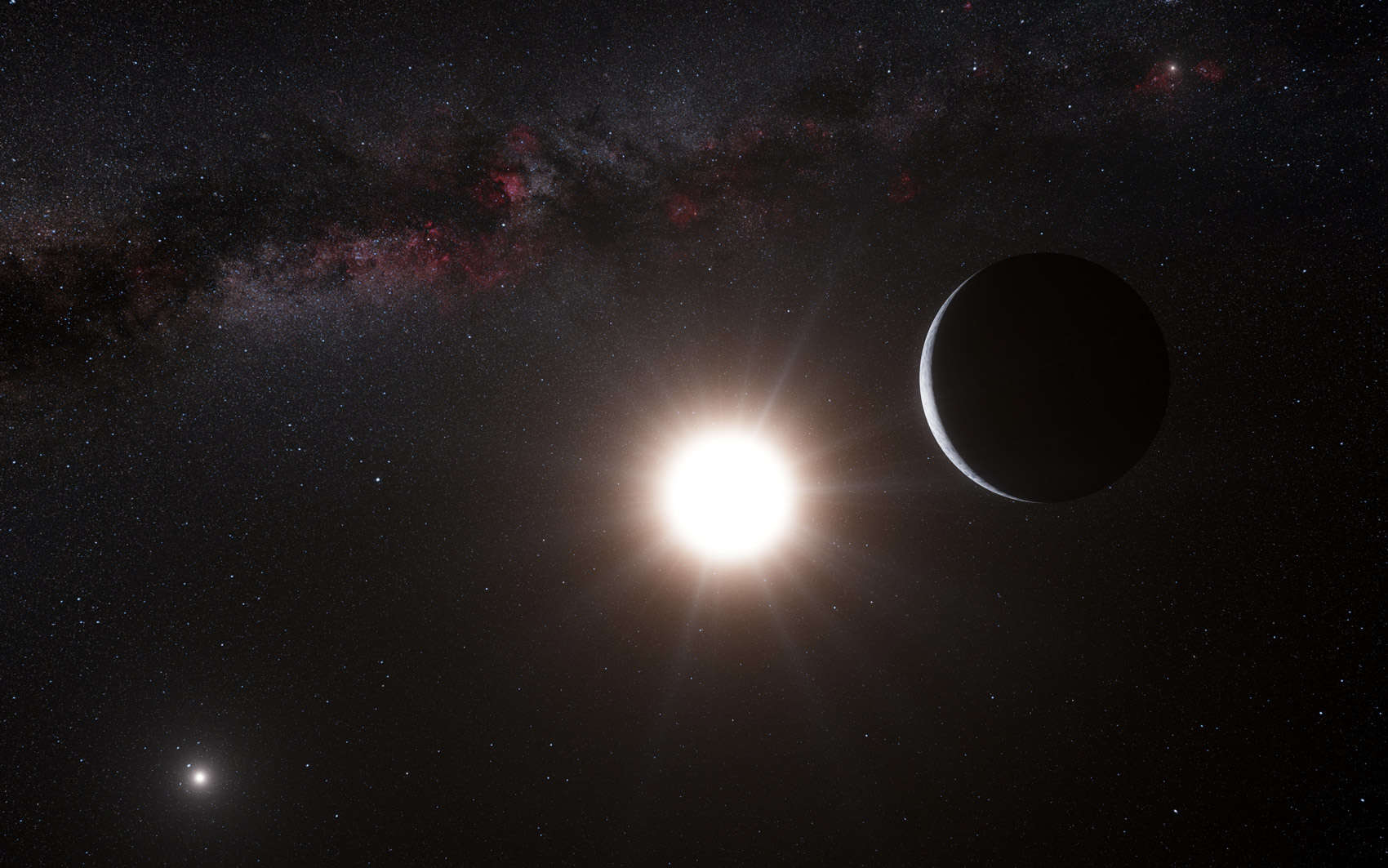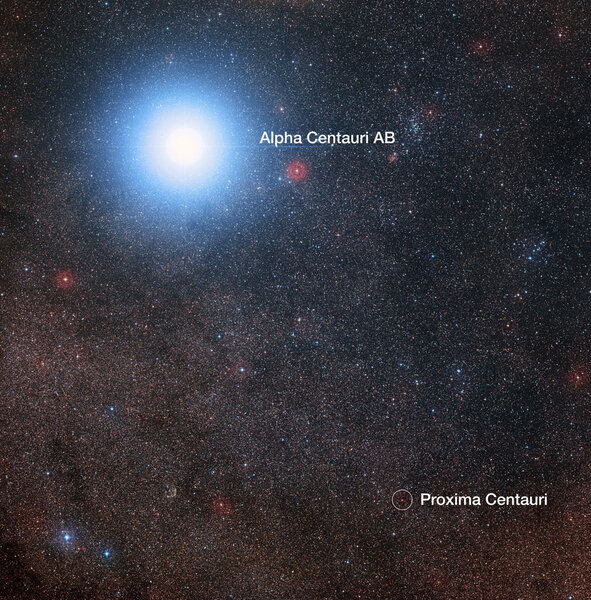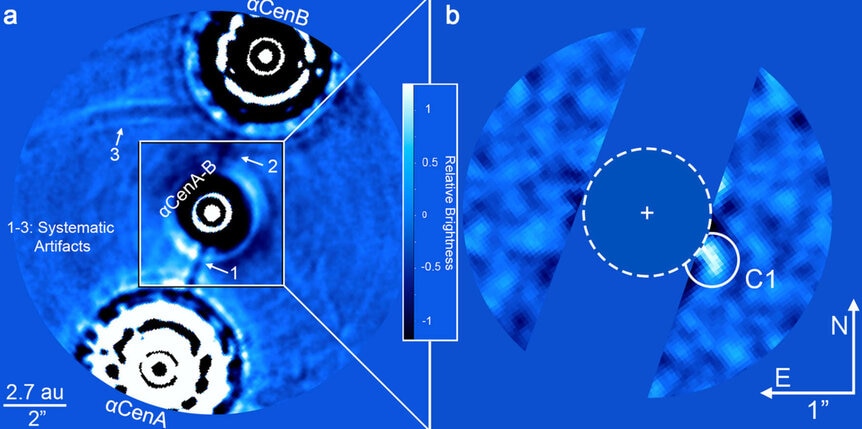Create a free profile to get unlimited access to exclusive videos, sweepstakes, and more!
Have astronomers finally found a planet around Alpha Centauri? Maaaaaaaaaybe.

A team of astronomers has found… well, something near one of the stars of Alpha Centauri that is consistent with it being a planet, possibly around the size of Neptune. However, to be very clear, it's not proven yet — it could be a dust cloud or it could even not be real at all.
Call me "cautiously interested." But if it is a planet, that would be very cool indeed.
Alpha Centauri is the closest star system to ours. It consists of three stars, a binary star consisting of Alpha Centauri A and B, both orbited by Proxima Centauri, a dim red dwarf. Proxima is likely to have at least two planets, and there's evidence for a third.
The binary is 4.37 light years from us. Alpha Centauri A (or α Cen A), is slightly more massive, hotter, and brighter than the Sun, and the other (α Cen B) is less massive, cooler, and dimmer than the Sun.
Because they're close to us it's easier to look for planets in their habitable zones, the distance from either star where liquid water could exist on a planet's surface. For distant stars that zone appears so close to a star that it's difficult to see due to the glare. With closer stars, it appears farther away and easier to spot. That makes α Cen a tempting target for direct imaging, literally taking an image of the stars and looking for an exoplanet in it.
In general this method is best using infrared (or IR) light, where stars are fainter and planets brighter, thus upping the contrast. It's worked well for quite a few exoplanets, but it favors ones that are far from their stars (where the background light from the star is weaker), massive (making them brighter), and young (they're still hot when a few million years old, so they give off more IR light).
Direct imaging is not optimized to look for Earth-like planets in habitable zones, which are cooler, smaller, and much closer in to their stars. However, new cameras and techniques may be able to see these planets that may not be bubbling cauldrons of heat.
New Earths in the α Centauri Region (or NEAR) is an experiment to use these new methods to look for planets around Alpha Centauri. It uses the monster 8.2-meter Very Large Telescope in Chile with a camera called VISIR: VLT Imager and Spectrometer for mid-InfraRed. Most IR cameras look at shorter wavelengths, around 5 microns (the reddest light the human eye can see is around 0.8 microns). VISIR looks at 10 microns, where cooler planets give off light, making it possible to see planets more like Earth.
This is what the astronomers used to look at Alpha Centauri over the course of 19 nights in May/June 2019. They got over 70 hours of useful observations, and used a lot of techniques to tamp down the brightness of the two stars, including putting them behind a metal disk (called a coronagraph) to block the light from the inner part of the star to reduce glare, subtracting one star image from another to reduce a lot of the light, and more. Some of these methods are fairly sophisticated, and are necessary to reduce the light of two of the brightest stars in the sky when seen by one of the largest telescopes on Earth.
They found a lot of artifacts — spots of light due to the processing techniques or reflections inside the telescope — making it difficult to know what exactly is real and what isn't. Still, they found a blip of light in a relatively clean part of the image where no known detector artifacts should be, and in the right spot to be a planet. It's seen in multiple images, which raises confidence it's real. Previous observations taken a few years ago rule out it being a background star or galaxy. Most intriguingly to me, when all the images are combined it forms an elongated blob, consistent with the orbital motion of a planet around α Cen A over the 19 nights of observations!
Still, and again I emphasize this, they can't be sure it's a planet, or even real. I'll note that there was a brief flurry of excitement over the discovery of a possible planet orbiting α Cen a few years back but it was later retracted.
But if it is a planet, given its brightness it fits with a planet between 3–11 times the diameter of Earth orbiting the star at about 165 million kilometers, 1.1 times Earths distance from the Sun. That's right in the star's habitable zone (closer to the inner edge, but still). Previous observations indicate no planet more than about 7 times Earth's width should exist there, so it's likely (again if real) to be a planet around the size of Neptune or so.
They note it may not be a planet, but instead a cloud of dust. The Sun, for example, has dust orbiting it shed from comets. It's faint, but would appear brighter in the mid-IR. They calculate that α Cen A would need about 60 times the amount of dust orbiting the Sun to explain the blob, which is a lot, but other similar stars have been seen to have more, so it's not out of the question.
So is this a planet orbiting α Cen A? Mayyyyyybe. The authors are properly circumspect about that in my opinion, not making huge claims or jumping to any conclusions. It looks like what they found is 1) real, and b) could be a planet.
Clearly, more observations are needed. I'd love to see some taken at a time when, if it is a planet, it would be on the other side of the star as seen from Earth due to its orbital motion. If they found it there (and nothing where they saw it before) then I would be a lot more confident it's real.
But as a proof of concept this new camera and the methods they employed are pretty encouraging. We know planets can exist around stars like the two in α Cen — our own Sun is proof of that, and we've found many planets orbiting stars in binaries — so there's no reason to think the stars don't have planets.
What we need is better evidence! But this is a very good start, and I hope more observations are coming soon. I grew up on sci-fi, and aliens from Alpha Centauri were so prevalent it was almost cliché to use them (Zefram Cochrane notwithstanding). Of all the stars in the sky, I'd be most excited about finding planets there.





























